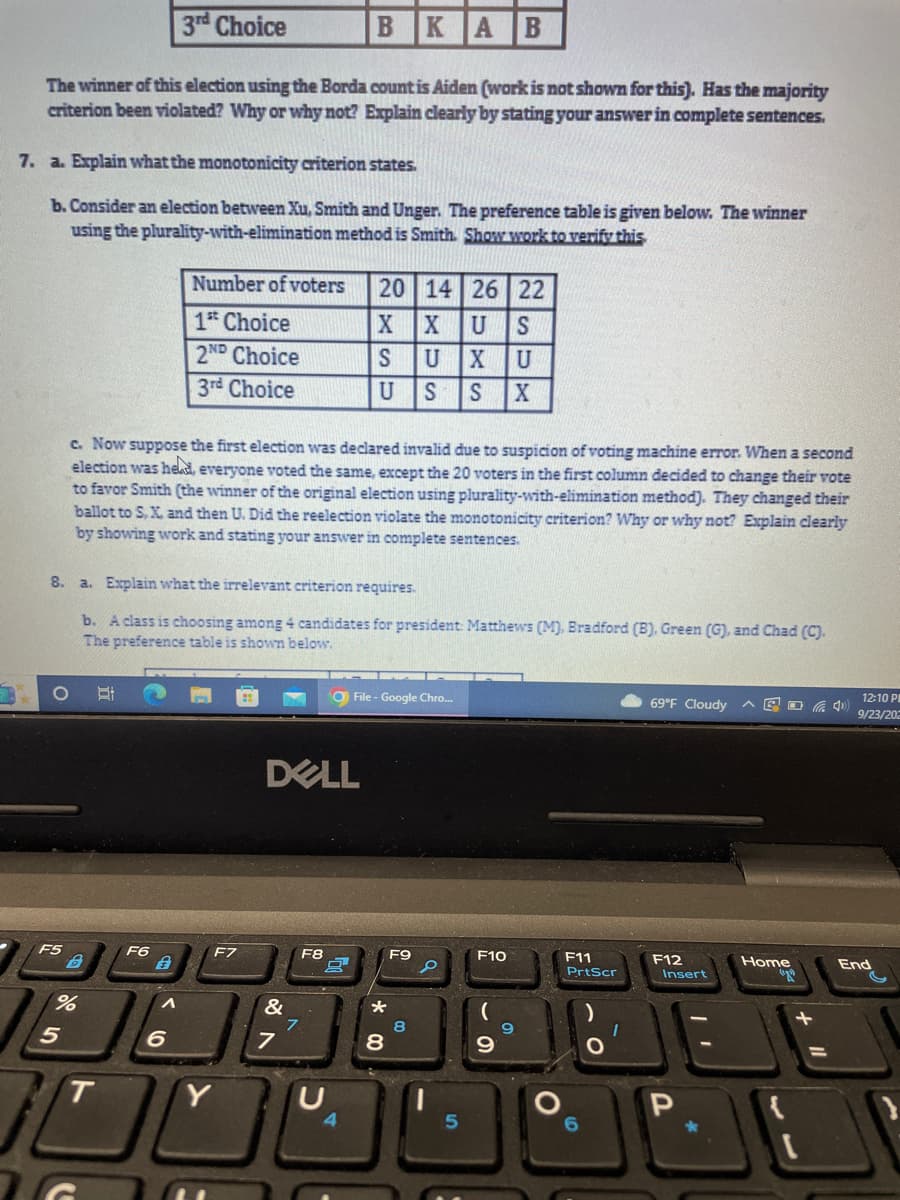7. a. Explain what the monotonicity criterion states. b. Consider an election between Xu, Smith and Unger. The preference table is given below. The winner using the plurality-with-elimination method is Smith. Show work to verify this Number of voters 20 14 26 22 X X U S US 1st Choice 2ND Choice 3rd Choice XS UX SUK c. Now suppose the first election was declared invalid due to suspicion of voting machine error. When a second election was held, everyone voted the same, except the 20 voters in the first column decided to change their vote to favor Smith (the winner of the original election using plurality-with-elimination method). They changed their ballot to S, X, and then U. Did the reelection violate the monotonicity criterion? Why or why not? Explain clearly by showing work and stating your answer in complete sentences.
7. a. Explain what the monotonicity criterion states. b. Consider an election between Xu, Smith and Unger. The preference table is given below. The winner using the plurality-with-elimination method is Smith. Show work to verify this Number of voters 20 14 26 22 X X U S US 1st Choice 2ND Choice 3rd Choice XS UX SUK c. Now suppose the first election was declared invalid due to suspicion of voting machine error. When a second election was held, everyone voted the same, except the 20 voters in the first column decided to change their vote to favor Smith (the winner of the original election using plurality-with-elimination method). They changed their ballot to S, X, and then U. Did the reelection violate the monotonicity criterion? Why or why not? Explain clearly by showing work and stating your answer in complete sentences.
MATLAB: An Introduction with Applications
6th Edition
ISBN:9781119256830
Author:Amos Gilat
Publisher:Amos Gilat
Chapter1: Starting With Matlab
Section: Chapter Questions
Problem 1P
Related questions
Question
i need b and c for number 7

Transcribed Image Text:3rd Choice
BKA B
The winner of this election using the Borda count is Aiden (work is not shown for this). Has the majority
criterion been violated? Why or why not? Explain clearly by stating your answer in complete sentences.
7. a. Explain what the monotonicity criterion states.
b. Consider an election between Xu, Smith and Unger. The preference table is given below. The winner
using the plurality-with-elimination method is Smith. Show work to verify this
F5
8. a. Explain what the irrelevant criterion requires.
b. A class is choosing among 4 candidates for president: Matthews (M), Bradford (B), Green (G), and Chad (C).
The preference table is shown below.
%
5
c. Now suppose the first election was declared invalid due to suspicion of voting machine error. When a second
election was held, everyone voted the same, except the 20 voters in the first column decided to change their vote
to favor Smith (the winner of the original election using plurality-with-elimination method). They changed their
ballot to S, X, and then U. Did the reelection violate the monotonicity criterion? Why or why not? Explain clearly
by showing work and stating your answer in complete sentences.
T
F6
Number of voters 20 14 26 22
XIX U S
S U X
U
U S S X
A
1st Choice
2ND Choice
3rd Choice
6
F7
DELL
&
7
F8
9
File - Google Chro...
10
*
00
8
F9
8
d
5
F10
(
9
9
O
F11
PrtScr
O
1
69°F Cloudy AGOG 4)
F12
Insert
| 1
*
Home
(29)
12:10 P
9/23/202
End
Expert Solution
This question has been solved!
Explore an expertly crafted, step-by-step solution for a thorough understanding of key concepts.
Step by step
Solved in 5 steps

Recommended textbooks for you

MATLAB: An Introduction with Applications
Statistics
ISBN:
9781119256830
Author:
Amos Gilat
Publisher:
John Wiley & Sons Inc

Probability and Statistics for Engineering and th…
Statistics
ISBN:
9781305251809
Author:
Jay L. Devore
Publisher:
Cengage Learning

Statistics for The Behavioral Sciences (MindTap C…
Statistics
ISBN:
9781305504912
Author:
Frederick J Gravetter, Larry B. Wallnau
Publisher:
Cengage Learning

MATLAB: An Introduction with Applications
Statistics
ISBN:
9781119256830
Author:
Amos Gilat
Publisher:
John Wiley & Sons Inc

Probability and Statistics for Engineering and th…
Statistics
ISBN:
9781305251809
Author:
Jay L. Devore
Publisher:
Cengage Learning

Statistics for The Behavioral Sciences (MindTap C…
Statistics
ISBN:
9781305504912
Author:
Frederick J Gravetter, Larry B. Wallnau
Publisher:
Cengage Learning

Elementary Statistics: Picturing the World (7th E…
Statistics
ISBN:
9780134683416
Author:
Ron Larson, Betsy Farber
Publisher:
PEARSON

The Basic Practice of Statistics
Statistics
ISBN:
9781319042578
Author:
David S. Moore, William I. Notz, Michael A. Fligner
Publisher:
W. H. Freeman

Introduction to the Practice of Statistics
Statistics
ISBN:
9781319013387
Author:
David S. Moore, George P. McCabe, Bruce A. Craig
Publisher:
W. H. Freeman